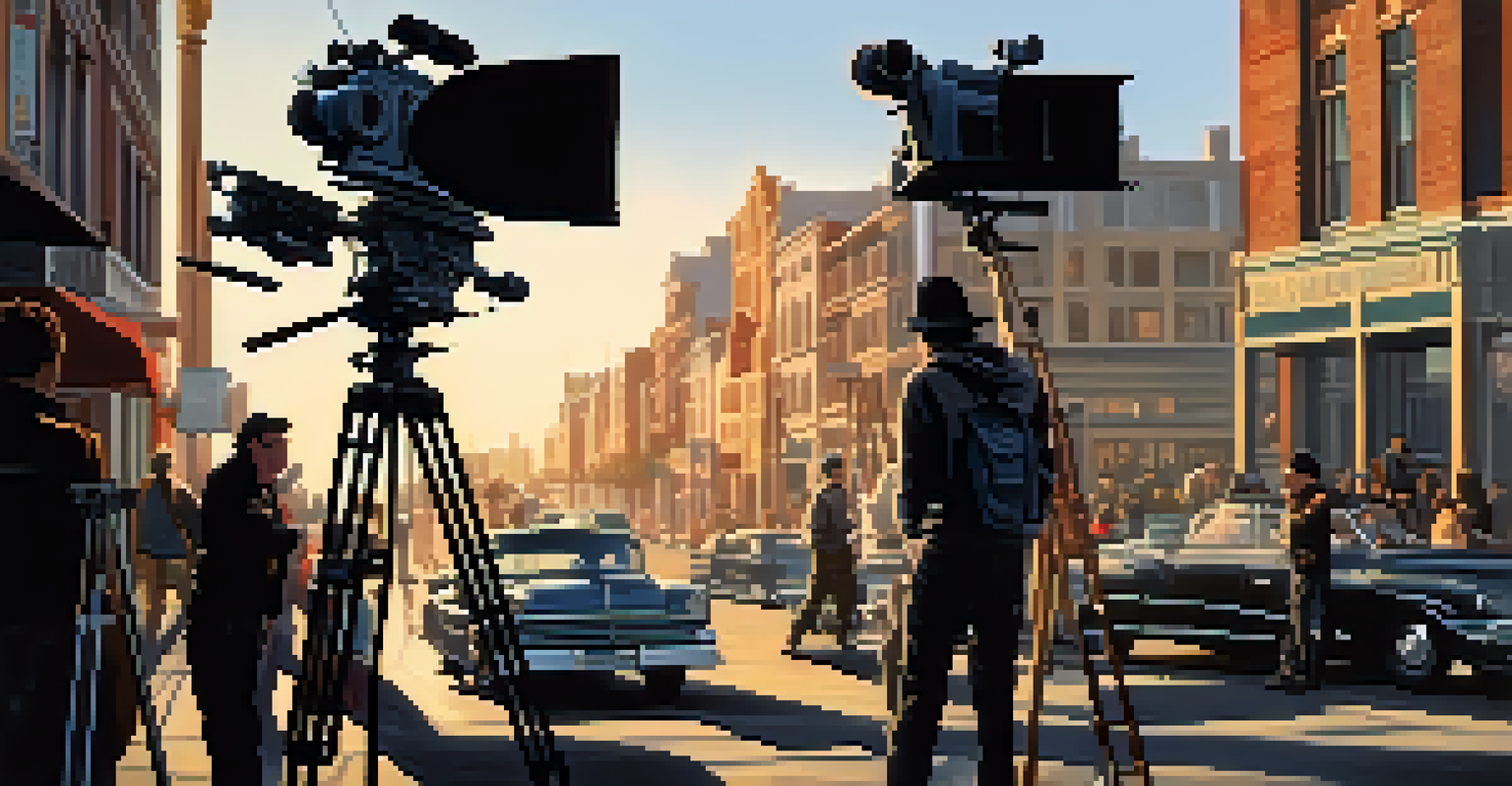The Intersection of Film Criticism and Social Commentary

Understanding Film Criticism as a Reflection of Society
Film criticism is more than just reviewing movies; it's a lens through which we can understand societal values and struggles. Critics often analyze how films depict various aspects of life, such as race, gender, and class, revealing underlying cultural tensions. By examining a film's themes and characters, critics can offer insights into the era's social dynamics, making criticism an essential tool for understanding our world.
The role of the critic is to make the audience aware of the social context of the film, not just to tell them if it's good or bad.
For instance, a film like 'Get Out' not only entertains but also sparks conversations about race relations in America. Critics highlighted how the film's horror elements serve as a metaphor for real-life fears and prejudices. This kind of analysis helps audiences engage with the film on a deeper level, connecting entertainment with critical thought.
Moreover, critics often challenge filmmakers to be more responsible in their portrayals of social issues. This relationship between criticism and content creation can lead to more meaningful storytelling that reflects the complexities of society. Ultimately, film criticism acts as a bridge, linking the art of cinema to the realities of life.
The Role of Social Commentary in Film
Social commentary in film serves as a powerful mechanism for discussing contemporary issues. Filmmakers often use their platforms to shed light on topics like inequality, climate change, and immigration, encouraging audiences to reflect on these pressing matters. By integrating social commentary into their narratives, filmmakers can provoke thought and inspire action among viewers.

Take 'Parasite,' for example; this film brilliantly critiques class disparity while engaging audiences with its thrilling plot. Critics praised how the film's storytelling not only entertained but also sparked discussions about wealth and privilege. Such films can create a ripple effect, prompting viewers to reconsider their perspectives and consider societal change.
Film Criticism Reflects Society
Film criticism serves as a lens to analyze societal values and struggles, revealing cultural tensions through the examination of themes and characters.
Furthermore, social commentary often varies based on cultural context, reflecting the unique challenges faced by different societies. This diversity in storytelling enriches the cinematic landscape, providing a platform for voices that might otherwise go unheard. As such, films that engage in social commentary become vital tools for fostering empathy and understanding across cultures.
The Impact of Critics on Social Change
Critics have a significant influence on the way films are perceived and can drive social change through their analyses. A well-articulated critique can elevate a film's message, encouraging audiences to engage with its themes more deeply. This power is especially evident when critics highlight overlooked social issues, prompting broader discussions and awareness.
Film is a powerful medium that can influence and reflect social change, serving as both a mirror and a hammer.
For example, when critics emphasized the feminist undertones in films like 'Wonder Woman,' it sparked conversations about representation in Hollywood. Such dialogues can lead to increased demand for diverse stories and characters, ultimately influencing the types of films that get made. Critics act as both commentators and catalysts, pushing for a cinema that reflects a wider array of experiences.
Moreover, social media has amplified this impact, allowing critics to reach wider audiences instantly. Online platforms provide a space for immediate feedback and discussion, which can shape public perception and even box office success. This interconnectedness between criticism and social awareness has never been more vital in our digitally driven age.
The Evolution of Film Criticism in the Digital Age
In the age of streaming and social media, film criticism has undergone a significant transformation. Traditional print reviews are now complemented by blogs, podcasts, and YouTube channels, making criticism more accessible to the public. This shift allows for a wider range of voices to contribute to the conversation, enriching the discourse around film and its social implications.
With platforms like Rotten Tomatoes and Letterboxd, audiences can engage in collective criticism, sharing their thoughts and ratings in real time. This democratization of film criticism means that everyone now has a platform to express their views, leading to a more diverse range of opinions. As a result, films that tackle social issues can gain traction through grassroots support.
Social Commentary Drives Change
Films that incorporate social commentary encourage audiences to reflect on contemporary issues, fostering discussions that can lead to societal change.
However, this evolution also raises questions about the quality and depth of criticism. While anyone can voice their opinion, not all critiques carry the same weight or insight. Therefore, discerning between insightful commentary and mere opinion becomes crucial in navigating this landscape, ensuring that meaningful discussions about social issues continue to thrive.
Cinematic Techniques Used for Social Commentary
Filmmakers employ various cinematic techniques to convey social commentary effectively. From symbolism to visual metaphors, these tools help communicate complex ideas in a way that resonates with audiences. For instance, the use of color palettes can evoke specific emotions or highlight disparities, making the film's message more impactful.
Consider the film 'The Hunger Games,' which uses a dystopian setting to critique social inequality and consumerism. The stark contrasts between the rich Capitol and the impoverished districts serve as a visual metaphor for class struggles. Such techniques not only enhance storytelling but also allow filmmakers to engage audiences in critical reflection on societal issues.
Additionally, sound and music play crucial roles in framing a film's message. The right score can amplify emotional responses, guiding viewers toward a deeper understanding of the themes at play. By combining these elements, filmmakers can craft narratives that not only entertain but also challenge and provoke thought, making social commentary an integral part of the cinematic experience.
Challenges Faced by Film Critics Today
Despite their influence, film critics face numerous challenges in today's fast-paced media landscape. The sheer volume of content available makes it difficult for critics to stand out and for audiences to discern quality critiques. Additionally, the rise of influencer culture has blurred the lines between traditional criticism and promotional content, raising concerns about authenticity.
Critics often grapple with the pressure to produce timely reviews, which can compromise depth and nuance. In a world where instant reactions are expected, taking the time to analyze a film's social commentary may be overlooked. This can lead to a superficial understanding of important themes that deserve thorough exploration.
Digital Age Transforms Criticism
The rise of digital platforms has democratized film criticism, enabling a broader range of voices while also raising questions about the quality of critiques.
Moreover, the polarized nature of online discourse can make it challenging for critics to voice their opinions without facing backlash. Critics may find themselves walking a tightrope, balancing honest critique with the potential for negative reactions from passionate fan bases. Navigating this landscape requires skill and sensitivity, ensuring that criticism remains constructive rather than divisive.
The Future of Film Criticism and Social Commentary
As cinema continues to evolve, so too will the role of film criticism and its relationship with social commentary. With emerging technologies like virtual reality and interactive storytelling, new avenues for engagement and critique are opening up. Critics will need to adapt their approaches to navigate these changes, ensuring that they remain relevant in an ever-shifting landscape.
The growing focus on diversity and inclusion in Hollywood also presents an opportunity for critics to champion underrepresented voices. By advocating for films that reflect a broader spectrum of experiences, critics can help shape the industry and encourage more socially conscious storytelling. This evolution can lead to richer narratives that resonate with diverse audiences.

Ultimately, the future of film criticism lies in its ability to foster meaningful conversations about the intersection of cinema and society. By embracing both traditional and modern approaches, critics can continue to illuminate the important social issues reflected in films, ensuring that cinema remains a powerful medium for dialogue and change.